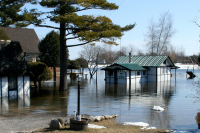May 14, 2019 – As homeowners and municipalities look to clean up after another record flood on the Ottawa River, the need to prevent such damage from happening again and again is clear.
We don’t yet know how much the 2019 flood will cost, but we know it will be much more than prevention. Hundreds of homes were damaged, millions of sandbags were filled, residents were evacuated, public infrastructure was compromised, and military and government staff logged significant overtime. And don’t forget the incalculable loss of photo albums and family keepsakes floating in soggy basements, and the exhaustion of homeowners and volunteers fighting the rising water.
But it could have been worse. Without current regulations, more homes and businesses would have been built in the floodplain, meaning more buildings damaged and more people affected.
The good news is, prevention is possible and infinitely cheaper than recovery – all we have to do is invest in it.
Ottawa’s conservation authorities are a key part of preventing flood damage, as they’re responsible for mapping flood-prone areas, monitoring flood conditions, giving municipalities and residents advance warning, keeping infrastructure like berms, dikes and dams in good working order, and prohibiting new development in flood zones. They also require homeowners in the floodplain to floodproof their homes and septic systems when they rebuild, to prevent future damage.
They do all this on a pretty tight budget (even tighter now due to recent provincial cuts), with the support of their partner municipalities.
Conservation authorities also prevent floods by planting hundreds of thousands of trees each year and protecting critical wetlands to build natural flood resilience right into our communities. Forests and wetlands act like sponges, catching and storing runoff so it percolates slowly into waterways. Without forests and wetlands, rain and snowmelt would have nowhere to go but directly into rivers and lakes, swelling them faster and higher.
Flooding is a natural function, and it will happen more often as extreme weather intensifies. And when today’s flood waters recede and the memories of sandbag walls begin to fade, conservation authorities will need continued public and political support when we are directing development away from floodplains, requiring existing structures to be floodproofed and taking steps to protect forests and wetlands.
We need financial support from all levels of government to continue updating floodplain mapping, operating and maintaining water control structures and monitoring flood conditions. It’s also time for the three levels of government to have serious conversations about buy-out and relocation programs for homeowners in the path of floods.
Cancelling the provincial 50 Million Trees program, reducing conservation authority funding and any weakening of regulations aimed at protecting wetlands or floodplains will only lead to more flooding and millions or billions in damages down the road.
Taxpayers foot the bill when major floods damage communities. Supporting the work of conservation authorities and municipalities to protect people and property from flooding in the first place is much better bang for our buck.
By Sommer Casgrain-Robertson, General Manager, Rideau Valley Conservation Authority
